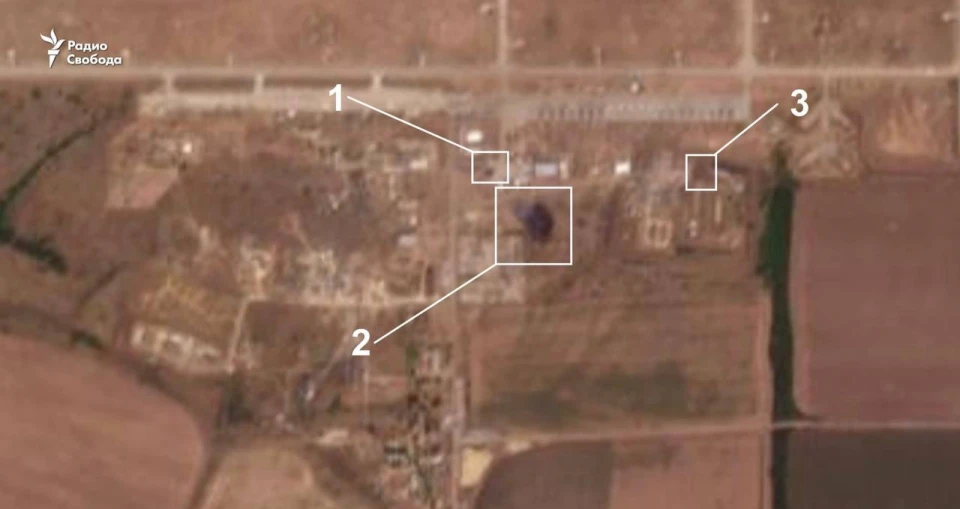
Impressive attack on Rostov air base, body armor production competition in Ukraine. Serhiy Zgurets’ column
Ukrainian drones targeted the Morozovsk airfield in the Rostov region, where a Russian bomber regiment operating Su-34 and Su-24 aircraft is stationed. The attack likely damaged the aircraft and could have also impacted the S-300 and S-400 launch systems intended to protect them
Results of Ukrainian drone attack on Rostov air base
War and the battlefield are becoming increasingly transparent. Earlier, we discussed the Ukrainian drone attack on the airfield in Morozovsk, and now there are already details, with the first satellite images of the airfield emerging. The Russian air base in Morozovsk, Rostov region, is over 300 km from the current front line. This base houses the Russian bomber aviation regiment with Su-34 and Su-24 front-line bombers. According to HUR head Kyrylo Budanov, 65 Ukrainian drones of two types — Bober and Lyutyy — were deployed at the air base in Morozovsk. These drones can cover a distance of 800 km. Budanov noted that the consequences of the strikes are still being evaluated. Several OSINT analysts examined satellite images post-attack, comparing before and after photos, and reported five blackened areas linked to the hits and fires. Analysts concluded that Russian air defense forces in the Rostov region might have lost part of an S-300 and S-400 launch system division intended to protect these bombers. Additionally, Ukrainian drones destroyed parked Su-34s and other Russian aircraft. The fire zone is also near fuel and lubricant storage and on the runway itself.

Millerovo Airport after the UAV attack on July 20
(Photo: screenshot from the video/Radio Svoboda/Telegram)
Ukraine's 110th brigade reports the downing of another Su-25
Russian aircraft are being destroyed both on the ground and in the air. I spoke with Ivan Sekach, press officer of the 110th Separate Mechanized Brigade, which has not only conducted operations west of Avdiivka but also destroyed eight Su-25 aircraft in May with MANPADS. On July 19, they reported a ninth Su-25 downed, and yesterday another Su-25 was shot down with a Stinger. I hope this trend of effectively using Stingers to target enemy aircraft continues and each event has a significant impact.
Ukraine’s State Rear Operator announces tender for 115,000 body armor units
The other day, the State Rear Operator revealed that on July 19, contracts for over 60% of the planned body armor purchases for the year could be finalized. Despite a tender for 115,000 body armor with an expected cost of nearly UAH 3 billion, only one supplier emerged. Temp 3000 offered to produce 15,000 bulletproof vests for UAH 390 million. However, over 90,000 units remain uncontracted. Funds for these bulletproof vests appear to be available. Although there are six certified body armor manufacturers in the country, none participated in the bidding except for Temp 3000. It's crucial to understand why this occurred.
Yuriy Fedorov, Director of the Kharkiv Plant of Personal Protective Equipment and co-founder of the association of volunteers and defense sector enterprises, stated that the State Rear Operator now operates with significant transparency. He noted that the past corruption scandals and previous practices are being forgotten. Such transparency was unprecedented even before the war.
Fedorov explained that the main reason their company didn't enter the tender for body armor supply was pricing. When the State Rear Operator requests pricing on body armor, the company provides the necessary information. The average price is always consistent and 20% less than the retail price. However, a company offers a price 10% lower than others, after which bids are announced, and other companies can't participate due to this lower price. Yuriy Fedorov pointed out that for the Ukrainian Armed Forces' material supply, the price is always revised upwards. With body armor, it's different. Pricing review for purchasing body armor is the most complex process in procurement.
Fedorov stated that the price at which Temp-3000 is ready to manufacture body armor is unaffordable for them and other companies. Temp-3000 showed they could supply body armor for the Ukrainian Armed Forces at a certain price, more than 10% of the entire market volume. Other companies might produce bulletproof vests at different prices. If other companies took orders at the price they could work with, all supply lots would be drawn, and production would already be ongoing.
Fedorov noted that since last August, there have been constant requests to revise the expected cost. Some companies offer lower prices that other enterprises can't match, leading to small tenders for material support. Prices are revised periodically. Now, their company has an order from the State Rear Operator, but most likely, a tender will be announced again with pricing suitable for Temp-3000.
Certification of body armor production in Ukraine
Yuriy Fedorov emphasized that the State Rear Operator uses democratic procurement methods. He stated that the distribution of company capacities for quick order execution depends on specific individuals. Even though the State Rear Operator has adopted transparent and efficient work methods, it has control bodies that can limit purchase costs. Fedorov also explained why their company cannot produce bulletproof vests at the same prices as Temp-3000.
He noted that there are approved standards for body armor production, including ballistic characteristics and weight. However, design and shape also matter. All companies producing bulletproof vests in Ukraine could submit their samples for experimental testing and offer their production. Bulletproof vests from Temp-3000 use ballistic materials more efficiently, which are the most expensive part of production. Fedorov mentioned that their company focuses on covering more lethal zones in body armor. Thus, their bulletproof vests will always cost a little more.
Ukraine’s Ministry of Defense tests lightweight body armor version
Ukraine's Ministry of Defense has announced that they are actively testing samples of lightweight body armor. Fedorov mentioned that all manufacturing companies are now welcome to submit their samples. However, the topic of lightweight body armor remains contentious. He clarified that the Kharkiv Plant of Personal Protective Equipment will not be part of these experimental tests. Yuriy Fedorov stated that the company has opted to allocate more resources towards modernizing and improving their current bulletproof vests. The focus is on enhancing materials and localizing production to minimize the dependency on raw material supplies.
- News












































